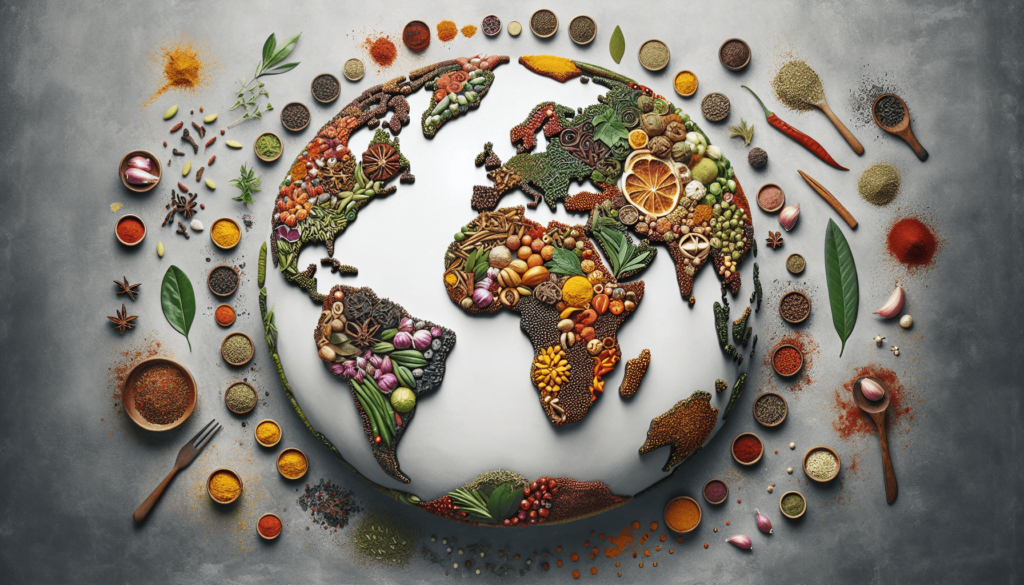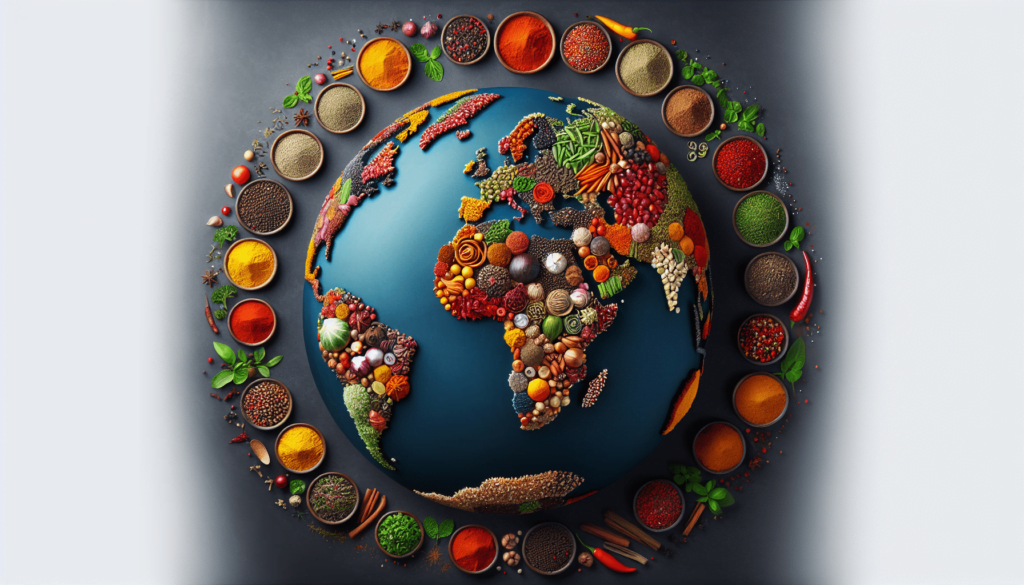flavors around the globe: A Culinary Journey” takes you on an adventure through the world’s most diverse and delectable cuisines, showcasing how food unites us all despite cultural differences. You’ll delve into the spices of India, the savoriness of Italian pasta, and the rich umami of Japanese sushi. This article not only highlights the historical roots of these delightful dishes but also brings to light the latest culinary trends and how they are reshaping our palates today.
From the significance of ancient cooking techniques to modern fusion cuisine, you’ll explore various perspectives that emphasize our shared global experience through food. Prepare to be amazed by the profound stories behind every bite, stirred by both tradition and innovation, and discover what the future holds for the culinary world. Have you ever wondered how the world tastes? If you could sample a dish from every corner of the globe, what stories would those flavors tell you about culture, history, and people?
Table of Contents
Flavors around the Globe: A Culinary Journey
Exploring the food of different cultures offers not just a unique gastronomic experience but a deeper understanding of our world’s incredible diversity. As borders blur and people become more globally connected, so does our access to the myriad flavors that characterize cuisines around the world.

Overview
Global cuisine is more than the sum of its flavors; it’s a story told through ingredients, preparation methods, and the communal act of sharing food. The act of eating is universal, yet the way we experience it can be vastly different depending on where we are. Exploring international flavors allows us to travel the world through our taste buds and celebrate the traditions and innovations that make each cuisine unique.
Thesis Statement
This article will take you on a delectable journey through the flavors around the globe, exploring how historical contexts, current trends, and different culinary philosophies shape what we eat. Not only will you learn about the history of various dishes, but you’ll also gain insight into why they continue to evolve and adapt to modern times.
Historical Context
To understand a cuisine, we have to dive into its history. Countries around the world have rich culinary traditions that have been shaped by their histories, geography, and cultures.
The Evolution of Italian Cuisine
Italian food, for example, has its roots in ancient Roman cuisine, which evolved significantly over centuries with influences from various invasions, trade routes, and the unification of Italy. Traditional Italian dishes such as pasta and pizza have simplistic ingredients but require meticulous techniques — a philosophy that reflects the nation’s broader emphasis on craftsmanship and quality.
The Birth of Indian Spices
On the other hand, Indian cuisine’s rich tapestry is woven from its history of trade and conquests. India’s strategic position on the spice route brought in an array of spices that became integrated into its culinary identity. Spices like cumin, coriander, and turmeric are not just flavor enhancers but also deeply rooted in Ayurvedic traditions, indicating the intertwining of food with holistic well-being.
Current Trends
The global culinary scene is continually transforming, influenced by modern societal trends such as health consciousness, sustainability, and fusion cuisines.
Revival of Traditional Methods
One notable trend is the revival of traditional cooking methods. Tandoori ovens, fermentation, and farm-to-table practices are making a comeback as chefs and food enthusiasts seek authenticity and sustainability. This is particularly evident in Scandinavian countries, where the New Nordic cuisine movement emphasizes local, seasonal ingredients prepared using ancient methods combined with modern techniques.
Rise of Plant-Based Diets
Another significant trend is the increasing popularity of plant-based diets. Countries like Israel are at the forefront, with Tel Aviv often dubbed the “vegan capital of the world.” This shift is not only altering local culinary landscapes but also blending with other cuisines to offer innovative vegan versions of traditionally meat-heavy dishes.
Key Concepts and Definitions
Understanding some key culinary concepts can enhance your appreciation of global cuisines.
Umami
Let’s start with “umami,” often referred to as the fifth taste. It’s a savory flavor found naturally in foods like tomatoes, cheese, and mushrooms. Originating from Japanese cuisine, umami has now found importance globally in enhancing flavor profiles.
Fermentation
Fermentation is a traditional preservation method that uses bacteria or yeast to convert sugars into alcohol or acids. This process isn’t just for making alcoholic beverages; it’s crucial for creating foods like sauerkraut, kimchi, and miso, which are rich in probiotics and add complex flavors to dishes.
Detailed Exploration
Now, let’s break down our culinary journey into various regions and their signature flavors.
Mediterranean Flavors: Italian Magic
Italian cuisine is a celebration of fresh ingredients and time-honored techniques.
Pasta: A quintessential part of Italian cuisine, the wide variety of shapes and sauces showcase the regional diversity. For instance, the creamy carbonara hails from Rome, while the robust Bolognese sauce originates from Bologna.
Pizza: More than just a fast-food item, traditional Neapolitan pizza is a carefully crafted dish that adheres to strict regulations, including the type of flour and tomatoes used.
Asian Aromas: A Symphony of Spice and Simplicity
Asian cuisine is incredibly diverse, each dish reflecting its region’s unique cultural and historical influences.
Japanese Sushi: Simple yet sophisticated, sushi’s art lies in the perfect harmony of vinegared rice, fresh fish, and minimal garnish. The philosophy of “less is more” is evident in every bite.
Thai Curry: A fragrant melange of spices, coconut milk, and fresh herbs, Thai curries are a sensory explosion. The balance of sweet, sour, salty, and spicy is the hallmark of Thai cuisine, representing the country’s rich agricultural landscape and historical ties to neighboring cultures.
African Tastes: Roots and Rhythms
African cuisine is a gastronomic journey through diverse cultures, landscapes, and traditions.
Moroccan Tagine: This slow-cooked stew, named after the clay pot it’s cooked in, combines meats, vegetables, and a medley of spices like cumin, cinnamon, and saffron. Tagine is a culinary representation of Morocco’s historical spice trade and community-oriented dining culture.
Ethiopian Injera: Made from fermented teff flour, this spongy flatbread is the foundation of Ethiopian meals. Typically served with a variety of spicy stews, injera’s unique texture and mildly sour taste offer a sensory delight for the adventurous eater.

Example 1: Soba Noodles in Japan
A timeless testament to Japan’s love affair with noodles, soba is made from buckwheat flour and can be served hot or cold. Traditionally enjoyed during New Year’s Eve for good luck, soba noodles have ingrained themselves in Japanese culture and cuisine. Their simplicity and nutritional value make them not only a staple but also a modern-day favorite in the global culinary scene.
Example 2: Mexican Mole
Mole, a rich sauce made from a variety of ingredients including chili peppers, chocolate, and spices, is an epitome of Mexico’s fusion of Indigenous and Spanish culinary traditions. It’s a complex dish symbolizing Mexican culinary heritage and has various regional versions, each with its own twist. Mole poblano, originating from Puebla, is perhaps the most well-known variety and reflects the intricate balance of flavors that Mexican cuisine is famous for.
Comparison of Different Perspectives
While the dishes mentioned reflect their cultural origins, modern interpretations and cross-cultural exchanges continually redefine these culinary classics.
Traditional vs. Modern Takes
Traditionalists argue for preserving the authenticity and time-honored techniques that define a cuisine. For example, making ramen broth can take up to 18 hours, a practice that many modern, quick-serve ramen spots might skip.
On the other hand, modern culinary innovators often blend traditional methods with contemporary twists. Fusion dishes like sushi burritos and kimchi tacos are emblematic of our interconnected world, where boundaries dissolve to create something entirely new yet comforting.
Impact Assessment
Exploring these varying perspectives reveals both challenges and opportunities. While traditional methods preserve cultural heritage, they may also limit the adaptation necessary for cuisines to thrive in a modern context. Conversely, fusion foods and modern interpretations make traditional cuisines more accessible but risk diluting their original essence.
Future Directions and Implications
As we look to the future, it’s clear that global cuisine will continue to evolve, shaped by societal needs, technological advances, and cultural exchanges.
Predictions
Expect to see a rise in sustainable practices such as zero-waste cooking and the use of local, organically sourced ingredients. Rapid urbanization and changing lifestyles also suggest a growing market for ready-to-eat meals that don’t compromise on quality or nutritional value.
Implications
The evolution of global cuisine has far-reaching implications for health, economy, and cultural preservation. Culinary tourism is likely to gain momentum, encouraging people to travel and experience new flavors firsthand, thereby enriching their understanding of different cultures.
Conclusion
In this culinary journey around the globe, we’ve uncovered how food is a powerful connector and communicator of culture, history, and innovation. From the meticulous artistry of Japanese sushi to the rich, communal flavors of Moroccan tagine, each dish tells a unique story.
So next time you sit down for a meal, think about the journey it took to get to your plate. Perhaps it will inspire you to explore a new cuisine, try a different recipe, or even travel to taste the world firsthand. Bon appétit!
Engagement
What are the unique flavors in your local cuisine that you think the world should know? Share your thoughts in the comments below, and let’s keep this culinary conversation going. Feel free to share this article and explore more resources for a deeper dive into global cuisines.
Credible Sources
Here is a list of credible sources used for this article. Please refer to these for more detailed information and further reading:
- “The Oxford Companion to Food” by Alan Davidson
- “On Food and Cooking: The Science and Lore of the Kitchen” by Harold McGee
- “Sapiens: A Brief History of Humankind” by Yuval Noah Harari
- National Geographic – Food Journeys of a Lifetime
- BBC Food – Discovering Global Cuisine
By weaving together history, current trends, and future predictions, we hope this article has given you a taste of how food connects us all. Happy eating!
Related site – Flavors of the World: A Culinary Journey
